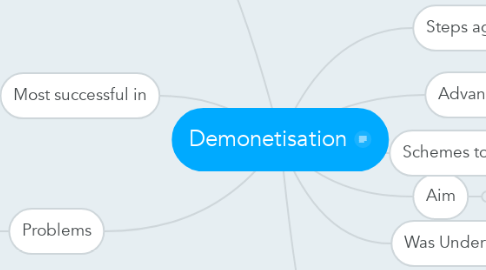Demonetisation
por Ashwathnarayan Rao


1. Problems
1.1. Danger of cyber crimes
1.2. Often it's not the technology that fails but carelessness on the part of the user
1.3. Only 10-15%of population have ever used non call payment compared to 40%of people in Brazil and China
1.4. In rural areas there are only 20.8% of ATMs
1.5. Less than quarter of the population owns a smart phone
1.6. Lack of IT infrastructure even after 70 years of independence
2. Most successful in
2.1. Sweden
2.1.1. One of the top 5 cashless ecomomy in the world
2.1.2. To go 100%cashless by 2020
2.1.3. Cash transactions made up barely 2% of the value of payments in 2016
2.1.4. SWISH a mobile app by major Swedish banks has enhanced the process to become cashless
3. Comparison with other counties
3.1. India and Sweden
3.1.1. India has only 75% literacy while Sweden has 100%
3.1.2. Per capita income is 435% of world average in Sweden but 14%in India.
3.1.3. 68% of Indian population live in rural areas; but 85.5% in Sweden live in urban areas
4. Was Undertaken in
4.1. 1946
4.2. 1978
4.3. 2016
5. Aim
5.1. Create a cashless economy
6. Steps against black money
6.1. PM proposal at G-20, Brisbane for sharing information regarding to base erosion and profit sharing
6.2. Govt agreement with Switzerland W.e.f 2019, details of assets held by Indians and vice versa.
6.3. Treaty with Mauritius, Cyprus, Singapore.
6.4. Black money Law-dealing with illegal assets outside India opened a window for disclosure with 60% tax and 10 year imprisonment
6.5. Income Tax Declaration Scheme-2016 with 45% tax.
6.6. The Benami Law legislated in 1988 and never implemented
7. Schemes to promote remonetisation
7.1. Lucky Grahak Yojana
7.2. Digital Dhan Vyapar Yojana
7.3. Bharat Interface for Money (BHIM)
7.4. Vittiya Saksharta Abhiyan
7.5. Rupay
8. Legal tenders are of 3 types
8.1. RBI act of 1934, gives the central bank the sole right to issue notes
8.2. Limited legal tender money
8.2.1. Coins
8.3. Unlimited legal tender money
8.3.1. Paper notes/currency
8.4. Non legal tender money
8.4.1. Cheques, bank drafts, bills of exchange, postal order
